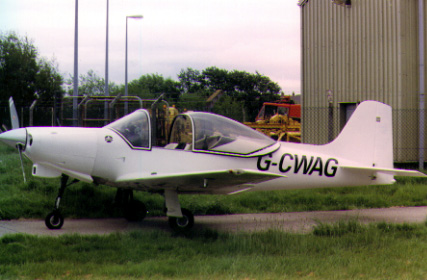The Falco Story,
C-CWAG
![]()
The Falco Story,
|
|
This article appeared in the June 1998 issue of the Falco Builders Letter. |
by Charles Wagner
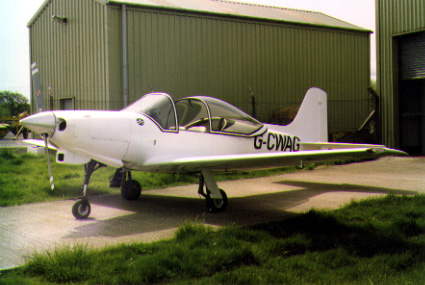
During moments of escapism I dreamed of bringing a radio controlled model Vickers Viscount in to land in a really very small garden.
Years later, when we were going through a very touchy time in the business I had started, we had made a loss of £18,000 in 1975, in those days, big money. I needed something to take my mind off the pressures building up on us. I came across some people flying radio-controlled models. At first I was prepared to build these and let my new acquaintances fly them but inevitably I was drawn into flying them myself.
I would work till 3 and 4 in the mornings in the kitchen building these models. My wife became very upset as her kitchen progressively showed more and more traces of paint and the surface of the lid of the big box freezer we had in those days became scored and eventually destroyed when I attempted to clean a spillage of epoxy paint with some particularly virulent thinners. My wife has suffered many of my "magnificent obsessions" during the years she has endured with me.
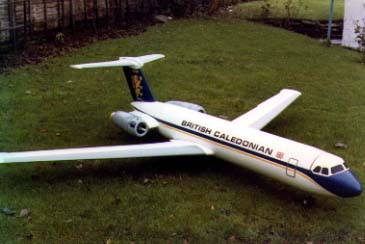
The BAC 111 that started it all
I was not content with the usual models available and gradually began designing twin engine jobs culminating in a 10' 6" BAC 111 powered by two Webra Speed 60's. Previous versions had flown particularly well but this one was really something, 30 lbs. weight, and requiring CAA permission to fly. I remember one occasion where a previous brute I had built had got out of control and like an Exocet missile, speared a Mk 10 Jaguar belonging to an enthusiastic radio control spectator, who would turn up wearing WWI leather flying helmet and gear. As I ran over to the scene of the accident, very apprehensive, expecting all hell to break loose, I asked the owner how the car was. "Never mind the car," he said, "how's the model?"
Anyway, I took my Flymo up to the strip and mowed out an extended runway. The aircraft was tied to the roof of my TR7 sports car, the wings in the air, almost lifting the car at any speed. I balanced the pumped fuel system to each aircraft engine and tuned these until they were running flat out with that incredible harmonized beat which makes shivers run up your spine. I let it go. It accelerated down the strip and slowly lifted its long nose off, its wheels brushing the long grass at the end.
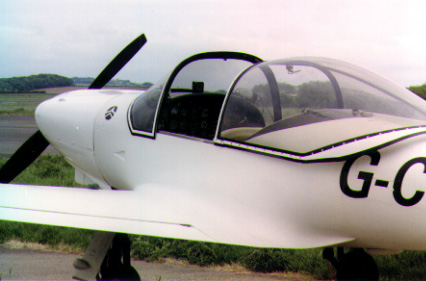
It was magnificent. She banked right and slowly dropped a starboard wing. I pulled full left rudder and ailerons, but I couldn't pick up that wing. She went into the ground. Those 15 seconds of flight were perhaps the most intense moments of my life. I remember looking at the broken plane in the double garage of the house I had built and thinking, shit, I could be sitting in the next one. That was fourteen or fifteen years ago. I never looked at models again until a few weeks ago when I thought that the big one could be redesigned and repaired for my 5-year old grandson. What else will I have to do when I finish working on the Falco? I was talking to another builder, Long-eze, Colibri and now a Bede. It's such an immense waste of knowledge and experience, never mind the bits and pieces and the tools, not to keep going and build another.
How it was that I got to know of the Falco I can't remember, maybe it was "Jane's All the World's Aircraft". I remember liking the looks of the Hovey Wing Ding and an appealing pusher, but of all the serious homebuilts I saw, the Sequoia which I mistook for the Falco, was the most interesting. The KR2 looked good, too. By this time, 1984 or 85, business had prospered again, and I could afford it. I bought the plans and got to know Brian Fox of Doncaster Sailplanes from whom I bought wood for the tailplane. The tail ribs were a massive bore and during the time I was making these I got to hear of the Glasair. A six-month flirtation followed during which no work was done but in the end I decided to stick with the Falco.
Luckily I bought Trimcraft wing ribs from a builder who'd given up. Progress was made in fits and starts, whenever the mood struck me. An injury to my back, I had tried to lift my 6' daughter up to a hatch in the ceiling, immobilized me for six months. I started a new business making plastic milk bottles and that set me back a long time. My son and I used to work 18 and 20 hours a day, day in and day out until we gradually learned what we were doing. Then three disks removed in my back put me out of action for a while and, to end the tale of woe, a hernia operation... I was not as young as I thought.
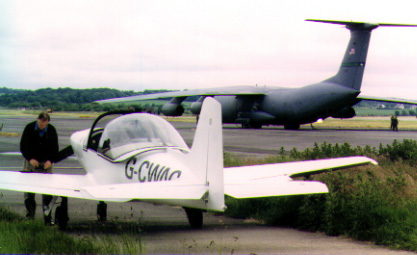
When I started the Falco I met the usual bunch of homebuilders. "You'll never finish it. It's the most complicated, difficult aeroplane to build." It has taken a long time, but I have finished, while only one of those tire kickers has completed an aeroplane, the rest are still talking. It has not been difficult, in fact, in retrospect, it has been incredibly easy, and it's been fun and therapy and absorbing and kept me away from pubs and loose women. I don't drink much, but I remember that women were fun. I remember my friends suggested that we should go out with the boys. Why? I'd much rather go out with the girls. I am a loner, I must admit.
I finished building our house before I'd thought of the Falco. Consequently and unfortunately, the house was not designed about the Falco, otherwise the garage would have been those two or three feet wider. The problem was that the wings fitted diagonally across the garage, just and no more, the other wing tip finishing in the boiler recess. I did not see one wing tip for years. I had to make up wing supports on swivel wheels so that I could maneuver the whole thing out on very odd occasions.
At nights I'd come home from the office, have a meal and a glass of beer and fall asleep at the TV. Even a small beer would put me to sleep. As often as not, another night wasted. I remember talking to a friend about how dedicated Stuart Gane was. He pointed out that Stuart never drank and the bugger would work his nuts off. His workmanship is superb. I'll never park close to him. His wife was extremely understanding. I got hell for neglecting my wife.
Stuart and I agree that much more time is spent pondering how we should do things than doing them. Stuart proved the point when he built a second Falco within two years, his first taking seven. Okay, he used all the kits, but it took him, alone, less than two years.
Last November I realized that the aircraft was only weeks from being finished. I shipped the two halves to Prestwick Airport, and it has taken fully seven months of hard constant work-well, nearly constant work-to finish. I retired in April. It is now June, and it is ready to fly, but not finished.
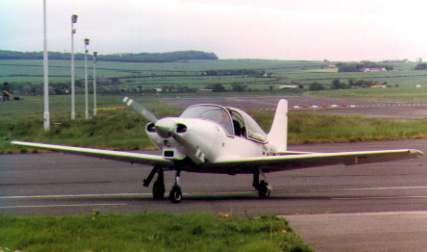
Looking back on it now, I feel that I wasted an awful lot of time making the metal parts. I'm a chemist, chemical engineer by profession and have had to spend time learning mechanical engineering operations like turning. I made all the components for the main gears and gave them to a foreman welder at British Aerospace at Prestwick who was going to jig and weld them. The welding was beautiful, but the jigging was pathetic. The main gear had to be thrown out, as were the rudder and control stick torque tube assemblies. The tanks were also beautifully welded, usable, but badly distorted. The welder was a welder, but he had only slept with a jigger.
During the protracted construction period, I have made good friends with similar interests, met interesting people, had a few arguments with Alfred, and I was seldom bored. I am very grateful to Stuart Gane, Gary Montgomery, Neville Langrick, my PFA inspector Tim and many others for their help and advice. Here I must also mention Basil. Basil was one of my old model flying pals with whom I had lost touch. A couple of months ago I met him at the shopping arcade and mentioned that I had to go down to Prestwick to work on the Falco.
He was thunderstruck. He'd thought that the project had been a pipe dream and now found that he'd missed the boat. He has worked with me ever since, day in and day out, and has been an enormous help. "Basil, get this. Basil, get that." We can take the panel out and put it back within two hours (Alfred, why do you put the bolts securing the centre console to the panel behind the centre console? These are a pig to get in. It would be much easier if the centre console had small lugs on either side which could be bolted to the panel outside the console.) He has a much better understanding of electrics and electronics than I and cleared up a few mistakes I had made. I have learned from him. I have realized only now how helpful it is having a building partner. My wife says that Basil and I are joined at the hip.
I'm trying to persuade him to get a pilot's license and build a Falco or even build a 33-foot sailing yacht to replace the one that the tax man took from him. We could do it in jig time.
My advice to new builders who do not come from an aviation engineering background, do exactly as the package advises, get the recommended engine, don't deviate or try anything smart, you'll land in very difficult territory. It took me months designing control cable supports and heat exchangers to fit my 0-320 E2A. I would not make any metal components myself again, I'd buy all of those kits.
Well, it is some weeks since I started this boring epistle at Alfred's insistence and the Falco has now flown. I told my wife, and she brought my two daughters down to the airport. Bob, the test pilot, ex-BA Captain, looked the airplane over. "It says in the book, no wheel doors for the first flight."
"But Bob, these aren't doors, they're half doors".
"Get them off," and he walked away. Basil and I looked at each other... typical BA Captain.
"Bob, are you scared?"
"Yes".
We heard him over the radio going up the coast north of Prestwick. He stalled it, played around and then switched to 123.450. "It's a nice airplane, Charles."
When he landed, someone said "Get the Champers out". My wife immediately opened her car boot (trunk), and there it was, a bottle plus glasses.
Since that day you can't keep Bob away from the aircraft. His only complaint is that it is noisy. It needed only a little trim tab on the aileron and a little one on the rudder. Until the flight checks are completed, the test pilot is not allowed a passenger. He did take me up however, as crew, to take notes. It flies like it is on rails. I could not believe that I had built something as good as this.
Basil, who has worked so hard on it, had a flight, also to take notes. We had to take a lot of notes. He got pretty excited. Can't stop the bugger talking about it.
We borrowed a parachute, and Bob did his Vne check and limited aerobatics. No bother atall.
"Bob, you saw the placard, 'Instrument Correction, Vne 200 kts.'"
"Oops," well, Vne 220 kts.
The aircraft is in primer, there are a few dings in the wing that need filling out, but I'll gradually work on that while I learn to fly it and have fun with it and leave the finishing touches till the winter.
